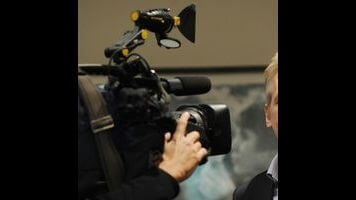Over the past decade or so, Headline News and CSI have transformed millions of Americans into armchair experts in everything from ballistics to blood spatters. Our collective fascination with forensic science is not so hard to understand: The idea that the truth can be divined from evidence as scant as a few fibers of carpet or the markings on a bullet casing is an intoxicating one, appealing both to our belief in the infallibility of science and, at the same time, to our far more abstract desire for justice. In “The Real CSI,” the latest report in a year-long joint investigation between NPR, ProPublica, and Frontline (who also produced last year’s excellent “The Child Cases”), correspondent Lowell Bergman reveals a troubling lack of regulation and standards when it comes to the discipline of forensic science.
Bergman makes the shrewd decision to begin the report with the case of Brandon Mayfield, a lawyer in Portland, Oregon who was arrested in connection with the 2004 Madrid terrorist attacks. The reason? His fingerprints were allegedly found on a bag of explosives at the scene of the attack. (It surely didn’t help that Mayfield is also an active Muslim.) Three fingerprint analysts hired by prosecutors and an independent expert all determined the prints were Mayfield’s. Though he’d never even been to Spain, Mayfield was the prime suspect. His Kafkaesque nightmare only ended when Spanish police independently traced the fingerprints to an Algerian man.
The takeaway from Mayfield’s story is that even fingerprint analysis, which the FBI until recently touted as “infallible,” is ultimately a subjective judgment. (Alas, those fancy computers that can make a positive match within seconds are but a figment of Hollywood’s imagination.) To quote Ken Moses, one of the experts who tied Mayfield to the Madrid bombings, any fingerprint identification ultimately comes down to “a leap of faith.”
The Mayfield case prompted a change in policy at the FBI—analysts are now discouraged from suggesting that their answers are “100 percent certain”—but it’s cautionary tale about our over-reliance on unverified and unregulated forensic science. If fingerprint analysis can be so horribly wrong, what about the less-established disciplines? The answer is yes, as Bergman learns from Judge Harry T. Edwards, the primary author of a report from the National Academy of Sciences which suggested there was very little actual “science” involved in many of the methods employed in criminal cases.
Perhaps the worst offender, according to Edwards’ report, is bite-mark analysis. Bergman points to a series of murders in small-town Mississippi for which two different black men, Levon Brooks and Kennedy Brewer, were convicted based on testimony provided by two purported forensics “experts.” After more than a decade, both men were exonerated based on DNA evidence—the only method, according to Edwards, that provides consistent results.
From here, Bergman takes an interesting and somewhat risky rhetorical shift to discuss the much-hyped Casey Anthony trial. Prosecutors in that case trotted out dozens of forensic experts, including one who attempted to verify the “smell of death” in Anthony’s car. Surely no one wants forensic science to be used to falsely convict innocent people, but should we buy into completely unverified methods if it means nailing someone who appears guilty as hell? Though it’s tempting to say yes, especially when it comes to Anthony, the problem is that jurors—rather than scientists—are essentially asked to conduct a peer review. As Peter Neufeld, co-founder of the Innocence Project, puts it, “There has to be a fix upstream.” Bergman deserves credit for asking the tough questions, and for acknowledging the noble intentions on both sides of the issue.
The most damning material arrives near the end of the hour, when Bergman turns to the subject of how forensic experts are certified and regulated—or not, as the case may be. As he discovers, there’s no central organization responsible for licensing forensic experts. Instead, there are a number of for-profit enterprises that churn out certifications. One enterprising journalism student at UC Berkeley was certified as a “forensic consultant” after forking over $660 and sitting for a brief, open-book exam. Bergman interviews Cyril Wecht, the chief spokesman for the for-profit American College of Forensic Science Examiners International, the largest licensing group in the country. Rather astonishingly, he says the licenses issued by his organization are tantamount to “résumé padding,” and are “designed to make someone feel good.” Tell that to Brewer and Brooks, who were both sent to jail by someone who boasted of his ACFEI credentials
While it’s easy to be shocked by this kind of flagrant charlatanism, Wecht and his colleagues are merely capitalizing on a void in oversight. In this way, the implicit message of “The Real CSI” is something of a harder sell: Some kind of government regulation of forensic science is needed, or inevitably dire mistakes will continue to be made.


 Keep scrolling for more great stories from A.V. Club.
Keep scrolling for more great stories from A.V. Club.